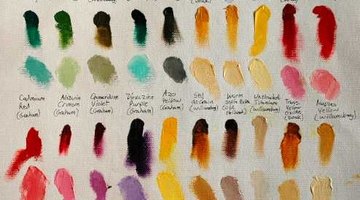How to Mix Acrylic Paints for Value Studies
Value studies teach artists how to use colors to their best effect. Paintings in which all colors have the same value, or brightness level, tend to look like comic book pages rather than having the depth and warmth of color expected in all but the most modern art.

Things You Will Need
- Acrylic paint
- Palette
- Water
- Bowl
- Paper towels
- 1-inch paintbrush
A work whose colors are all bright overwhelms the viewer, while a work in all dark colors is somber, depressing, or foreboding. That is fine if those are the effects you are trying to create for the viewer, but if you want to startle startle or intrigue, you will have to use a variety of values.
-
Print several copies of the Greyscale Worksheet (see Resources below).
-
Begin with white acrylic paint. Squeeze a little white paint onto your palette. Thin with a drop or two of water. Dip your brush in the paint and stroke brush rapidly back and forth to be sure the water has completely mixed with the paint.
-
Making a smooth motion from top to bottom, paint the first rectangle on the top left side of the Greyscale Worksheet. Use only top to bottom strokes, not side to side or cross hatched strokes.
-
Squeeze out more white paint. Add a drop of your chosen color and mix well. Load your brush again and paint the next rectangle, again using top to bottom strokes only.
-
Continue to add additional drops of color to the same amount of white paint each time, making one sample rectangle per each change in value. When you reach a color nearly identical to your chosen color, begin adding black acrylic paint, one drop at a time to an amount of your chosen color. Make a swatch for each of these shades as well. Let dry.
-
Choose the swatches that best show the changes in value from white, to full color, to black. Label each with the number of drops of white, black, or color needed to reach that value. Arrange the swatches on a chart from lightest to darkest. Use them as paint chips to match colors when you blend them.

Tip
Add color to white rather than white to color for best results. Add opaque colors to translucent colors. Work from lightest to darkest. Use strokes from top to bottom, not side to side or cross hatched.
Resources
Tips
- Add color to white rather than white to color for best results.
- Add opaque colors to translucent colors.
- Work from lightest to darkest.
- Use strokes from top to bottom, not side to side or cross hatched.
Writer Bio
Jane Smith has provided educational support, served people with multiple challenges, managed up to nine employees and 86 independent contractors at a time, rescued animals, designed and repaired household items and completed a three-year metalworking apprenticeship. Smith's book, "Giving Him the Blues," was published in 2008. Smith received a Bachelor of Science in education from Kent State University in 1995.
Photo Credits
- www.rourkevisualart.com/wordpress/index.php?s=ochre, http://painting.about.com/od/colourtheory/ss/ColorClassTones_8.htm
- www.rourkevisualart.com/wordpress/index.php?s=ochre, http://painting.about.com/od/colourtheory/ss/ColorClassTones_8.htm
More Articles


